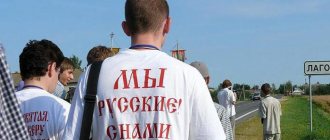We all like to ask ourselves sometimes about something that no one else thought to collect information about.
For example, how many pigeons are there in the world? Or - why sometimes it seems that snowflakes are flying upward, although they are falling?
How many churches are there in Russia? or how many people go to church - questions, oddly enough, are of approximately the same nature. It is very interesting to learn about this, but, as it turns out, few people can say anything for sure about it.
We decided to check the Internet. We entered several questions into the search engine. For example: how many priests are there in Russia or how many Orthodox monasteries are there in the world. And this is what they saw.
How many Orthodox are there in Russia?
There is no data more vague than that which would indicate the religion of people - in a particular country or throughout the world.
Why?
For example, to the question of how many Orthodox Christians there are in Russia, one can answer - 70% (this is the latest data from some agency, and in general - various studies call “plus or minus” the same figure: 60–70%).
But how many of them at least occasionally go to church, and do not just say that they are Orthodox?
In 2021, on Easter - the day when even those who attend services once or twice a year come to church - 4.3 million people attended night services throughout Russia (these are official data from the state, which will definitely not understate the figure) . That is, a little less than 3 percent...
In Moscow alone, one million people were reported in the same year—8.3 percent. Of course, some parishioners could stay at home - for one reason or another, but still this is not seventy percent...
How many churches does Russia need?
The chairman of the synodal department for relations between the church and society and the media, Vladimir Legoyda, clarified the data presented by the patriarch. In fact, we are not talking about 30 thousand, but about 9386 new churches. At the beginning of 2009 there were actually about 30 thousand, or more precisely 29,263, and after 10 years (at the beginning of this year) the number increased to 38,649 churches and other places of worship (an increase of more than 30%). We are talking about places of worship around the world. If we talk about Russia, then compared to the time that has passed since the collapse of the USSR, the number of churches in Russia has grown from approximately 2 thousand (we are talking about operating ones) to 21,849 now.
However, there is still some confusion with temple statistics. that he spoke at the end of 2021
Chairman of the Synodal Department for External Church Relations, Metropolitan Hilarion of Volokolamsk. He then cited statistics according to which “throughout this entire period we built or restored from ruins a thousand temples a year, or three temples a day.” These statistics apply to the entire Russian Orthodox Church in Russia, Ukraine, Belarus, Moldova, Kazakhstan, other republics of Central Asia, the Baltic states and far abroad. “In the far abroad, including the Russian Church Abroad, we now have about 900 churches in 60 countries,” Metropolitan Hilarion said then, clarifying that “our number of churches now approaches 40 thousand. At this rate, in 30 years we will have 70 or 80 thousand churches.”
It is important to note that, as a rule, the construction of churches is financed by private sponsors. And in principle, they can spend their money as they see fit - even on churches, even on the development of education and science, even on hospitals or private schools, even on creating space rockets with their own money, as Elon Musk does. It's a matter of priorities. Both specific private sponsors and society as a whole, which forms such priorities. Or allows you to shape. True, the question arises - how voluntarily do they chip in?
However, a significant share of the construction of religious buildings is financed by state corporations. Here the question is more complicated. It turns out that the state, as the main shareholder of such structures, is not completely separated from the church, and she is from it. If the state tells, say, state corporations how much they should pay in dividends, then it also “indicates” (or agrees, at a minimum) how many churches they should build? Or does top management have autonomy in decisions? But why on earth?
How many churches does our country really need? If we take the figures given by Legoyda, then with a population of 146.7 million people we now have one church (or room for prayers and liturgies) for approximately 3.8 thousand people. The placement of religious objects, of course, is uneven. Where is empty and where is thick, as they say. According to the same Legoyda, in the Novosibirsk diocese, for example, there are 25,000 people per Orthodox church.
But we are talking about the population as a whole. But not all believers are Orthodox. It is known, for example, that approximately a quarter of the Russian population is Muslim. There are also Jews, Buddhists and so on. It's scary to say that there are atheists. Although approximately 80% of Russians consider themselves Orthodox during sociological surveys (about the same percentage consider themselves Russian), perhaps in this case people often confuse religion and nationality. However, active believers who regularly attend church and fast are no more than 5-6% of the population. Thus, according to the Ministry of Internal Affairs, 4.3 million people across the country came to the Easter service this year (100 thousand less than last year). Based on the last figure, on Easter there was an average of one church per 111 people. Does this figure indicate an acute shortage of churches in Russia?
Now let's talk about money and priorities. On average, the construction of one temple for 500 parishioners costs investors 300 million rubles, for 250 - 90 million. Even if we take the last figure, then with the construction of three churches per day (more than a thousand per year), we will get a volume of temple construction approaching 100 billion rubles per year.
If investors, we repeat, are more interested in spending their money on churches rather than, say, on schools and private space programs or scientific grants, then these are their priorities, supported, as we understand, by officials at the appropriate levels of government.
It is also necessary to take into account the laying of communications to religious buildings - and they are both a sore point for a summer resident and a small entrepreneur. For example, the problem of connecting communications to free land plots for large families has existed for years.
By the way, if we talk about schools, the prices will be comparable. If we talk about average figures, then in principle it is possible to meet 200 million rubles for a school with 500 students. However, when we are talking about a modern school with proper equipment, you will have to pay from 300 to 560 million and more (Glavgosexpertiza estimates), depending on climatic conditions and the region. For example, a modern well-equipped school for 550 places in Yekaterinburg will cost from 377 to 391 million rubles. For comparison, a preliminary estimate of the cost of building the Church of St. Catherine in the park near the Drama Theater in the same city amounted to 3.5 billion rubles.
The number of schools in Russia, unlike the number of churches, is not growing, but is steadily falling. Today there are about 53.5 thousand schools in the country. 13.4 million schoolchildren study there. About three times more than active parishioners. In recent years, over 12 thousand secondary educational institutions have been closed, of which about 10 thousand are schools located in rural areas. The need for new schools is estimated at 14 thousand for the period until 2025.
Of course, the decline in the number of schools was affected by the fall in the birth rate. But don't the same demographics apply to churches?
The situation with hospitals is even worse. In 2000, there were 10.7 thousand hospitals and other medical institutions in the country. Now there are approximately 5 and a half thousand left. The rate of closure is approximately one hospital per day. Why don't the same investors who are willing to spend money on temples want to become famous by building a hospital or a school? A rhetorical question.
The state, by the way, is also a “donor” in this regard. About the scale of numbers. At the beginning of this year, Prime Minister Medvedev signed a decree allocating subsidies to the regions for the construction and reconstruction of 53 healthcare facilities. 45 regions will receive funds from 2021 to 2021. We are talking about the federal project “Development of children's healthcare, including the creation of a modern infrastructure for providing medical care to children” of the national project “Healthcare”. 70 billion rubles will be allocated over three years. This is less than the volume of “temple construction” per year. Carried out, we recall, including through donations from state corporations.
By the way, money is allocated to the Russian Orthodox Church, including directly from the state budget - through state channels: for various “cultural” items, for example, for the preservation of cultural heritage sites, through various grants of a socio-cultural nature, etc. The order of numbers is at least 10 billion rubles per year or more. For comparison, the same 100 billion rubles will be allocated for the entire national project “Culture” for the period 2021–2024.
With such socio-religious policies and priorities fixed at the level of the ruling elite and the business community, ordinary people - both believers and everyone else - can only pray. Who will be able to do it to whom and on whom and deems it necessary.
How many Orthodox are there in the world?
The figures that are published to answer the question of how many Orthodox Christians there are in the world also vary - both depending on who gives them and depending on the evaluation criteria. There is no way to calculate it accurately, and any method will have a flaw.
Therefore, we can speak approximately about the number of Orthodox Christians on earth. The picture turns out like this:
As of 2021, there are 7,500,000,000 people living on Earth—seven and a half billion.
Of these, almost a third - 2,400,000,000 - are Christians of one denomination or another.
Slightly more than half of all Christians are Catholics. 1,200,000,000
see also: Catholicism and Orthodoxy: differences, the most important thing
There are about 300 million Orthodox Christians in the world.
The number of believers in Orthodox Local Churches can also only be estimated approximately, and most often these figures are higher than how many actually go to church. Wikipedia shows this table (we publish the first six):
- Russian Orthodox Church - 90–120 million
- Romanian Orthodox Church - 18,800,000
- Greek Orthodox Church - 9,000,000
- Serbian Orthodox Church - 8,000,000
- Bulgarian Orthodox Church - 6,350,000
- Georgian Orthodox Church - 3,600,000
And we must not forget the “Orthodox diaspora”, which lives in Catholic or Protestant territories, where they are either almost or completely deprived of the opportunity to regularly visit an Orthodox church.
Trinity Church in Paris. Photo: patriarchia.ru
Here are the figures for the Russian diaspora in European countries provided by the portal pravoslavie.ru
- Germany - 660,000
- France - 150,000
- Sweden - 94,000
- Benelux - 67,000
- Italy - 32,000
- Switzerland - 23,000
Patriarch Kirill named the exact number of churches and priests throughout Russia
Church ministers working in prisons know more about criminals than investigators, but the secret of confession imposes restrictions on them. Confession of believers in prisons and spiritual conversation defuse the difficult atmosphere in places of detention. According to the census of prisoners for 2009–2010, the number of believers (Orthodox) in prison is 67%.
As statistics of believers in 2021 show, 4.3 million Russian residents visited churches on Easter. Distribution by some areas:
| Region | Number of believers who visited the temple, thousand people |
| Bryansk | 116 |
| Kaluzhskaya | 30 |
| Smolenskaya | 28 |
| Samara | 48,7 |
| Kursk | 95 |
| Yaroslavskaya | 27 |
| Tyumen | 20 |
It is quite difficult to determine how many believers there are in the world. Data vary depending on survey methods. It is possible to trace some trends occurring in Europe. Data provided by the Catholic and Protestant churches on believers in Germany in 2011 indicate a decrease in the total number of religious adherents from 64.5 to 61.5% over the previous five years.
According to data for 1914, there were more than 54 thousand churches on the territory of the empire, and this number included not only monasteries, but also houses and cemeteries. Only military churches were not taken into account. There were also 25.5 thousand chapels and more than a thousand monasteries. During the reign of Soviet power, a lot was destroyed irrevocably, so it is almost impossible to determine exactly and in full which churches were destroyed. Some of them were completely dismantled or the buildings exploded.
How many priests are there in Russia?
The report, which Patriarch Kirill read at the end of 2021, provides the following figures:
As of 2021, in Russia there are 34,774 full-time elders (that is, priests) and 4,640 deacons. Total - 39 thousand clergy.
This means that there are 4,000 people per priest in the country.
Perhaps, however, this report does not take into account hieromonks - then the number of clergy will be higher.
see also: Who is a hieromonk?
By the way, there are as many as 27 countries on Earth where there are fewer inhabitants than we have priests










